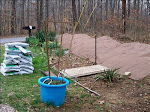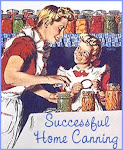To hear the song about Golden Acre, winner of the 1945 U.S. Victory Garden of the Year award, please click: http://cdbaby.com/cd/wmalanross3.
This week I caught up on the things I neglected in the past six weeks. I spent the entire day with my 14 yo granddaughter; I cooked food for the week, cleaned house, caught up on laundry and email, read a Jodi Picoult novel. In six fast weeks Hub and I have stored enough food, water and emergency supplies to last six or more months, planted a small vegetable garden, cached enough water to irrigate the garden beds, started a composting system, cleared out space for storing supplies, and brought order to our lives in the process. Hub is interested, involved and engaged in the process—this is his first experience at gardening.
Reports from the field: Gas prices in middle Tennessee are at 3.999/10 for regular gas and up to 4.79 for diesel. We’ve saved receipts that reflect the drastic increases in the cost of gas and food. The liquor store owner tells me our favorite Riesling went up $3 per bottle this week. He’s also paying a new $25 delivery charge per order from his supplier due to gas price increases. [That apple jack is soundin’ mitey good.] Our electric usage was up $20 from last month, due to a/c use during this June hot spell. Our auto gas usage was down because we’re consciously making one trip for all errands and to Nashville.
For Food Independence Days course:
Planted: Cilantro, watermelon, transplanted sickly Early Girl tomatoes and sun-burnt ferns.
Harvested: basil, chives, Greek oregano
Prepped: I ordered three books from http://www.half.com/ on making tinctures, salves and other herbal remedies. Kitchen Witchery: Marilyn F. Daniel, Spagyrics: Manfred M. Junius; and The Herbal Home Remedy Book: Joyce A. Wardwell. I plan to buy Everclear to use for tinctures before the prices skyrocket.
Stored: Sometimes it seems dumb to post the things we buy for food storage. Yet my experience has taught me that I can learn a lot from reading posts from other course members. For instance, isn’t it a great idea to store up a little WD40 and 3-in-1 Oil? Prices on those bubbies are bound to go up.
Beef Bouillon x 10 cans
Chicken Bouillon x 10 cans
Tuna packed in water x 25 cans
Canned pears w/o sugar x 10 cans
Canned peaches w/o sugar x 10 cans
Mandarin oranges x 10 cans
Almonds
Cocoa Mix (commercial size) 5#
Baker’s High Protein Flour
Brownie Mix (commercial size) 6#
Soups for bases (celery, mushroom, consommé)
Buttermilk Pancake Mix (commercial size) 10#
Mrs. Butterworth’s syrup (commercial size) 1-gallon
Baking Soda x 8#
Bleach x 1½ gallons
Apple Juice x 4 gallons
Pinto Beans x 20#
Toothpaste x 4 giant tubes (be sure to buy toothpaste with the ADA symbol!)
As you can see, these supplies include comfort foods. Peggy Layton’s plan calls for storing comfort foods.
Water: Our new water catch did well in the rain we (finally) got this weekend. After one rain shower the 110-gallon container was 3/5 full, even though I lost a lot of rainfall because my setup leaked. I’ve since corrected the leak problem. I hope to gather enough water to carry the gardens through the season.
Recycled, Reused: Washed my plastic bags, Ziplocs, etc. in the small delicates tub I have for my washer. Then I hung the bags on my garage clothesline. [We have a clothesline strung in the garage. The clothes dry quickly in the heat and there’s no danger of bird flyovers.] This method worked better than hand washing or dishwasher washing the plastic bags. We have since strung additional clotheslines in our garage [we don’t store the cars in the garage.] I can hang an entire load of clothes on the garage line, still, not fearing bird flyover.
I also raked up grass cuttings. We purposely let our grass grow tall so we can harvest the grass for composting.
As always we composted everything.
Recycled our bottles and plastic to the recycling center.
Used metal cans for energizing in the garden.
Used milk cartons for short-term dry storage of 20# pinto beans.
Taking a cue from Touch the Earth Farms, I run the vacuum less. This cutback presents a difficult situation since we’re allergic to the Himalayan cats we adopted. We have carpets, and the cats are long-haired…that is an issue we aren’t sure how we’ll deal with in the future.
Learned something new: We have carpenter bees in our deck rails, so I researched them. Keep in mind as you read that our deck is made of pre-treated lumber and we sealed it twice last year. “Carpenter bees tunnel into wood to lay their eggs. Bare, unpainted or weathered softwoods are preferred—especially redwood, cedar, cypress and pine. Painted or pressure-treated wood is much less susceptible to attack. Common nesting sites include eaves, window trim, siding, wooden shakes, decks and outdoor furniture. Carpenter bees overwinter as adults in wood within abandoned nest tunnels. They emerge in the spring, usually in April or May. After mating, the fertilized females excavate tunnels in wood and lay their eggs within a series of small cells. The cells are provisioned with a ball of pollen on which the larvae feed, emerging as adults in late summer. The entrance hole and tunnels are perfectly round and about the diameter of your finger. Coarse sawdust the color of fresh cut wood will often be present beneath the entry hole, and burrowing sounds may be heard from within the wood. Female carpenter bees may excavate new tunnels for egglaying, or enlarge and reuse old ones. The extent of damage to wood which has been utilized for nesting year after year may be considerable. Mechanical Measures. A non-insecticidal management approach is to deny carpenter bees access to their galleries by sealing each entrance hole. Thoroughly plug the hole with caulking compound, wood putty, or a wooden dowel affixed with wood glue. If possible, also fill the entire gallery system with a sealant. Carpenter bee galleries are a critical resource, since the bees spend much of their time inside a gallery, and they require its protective conditions to survive the winter. Bees that are trapped inside a caulked gallery typically will not chew out due to behavioral constraints. This barrier approach has promise for reducing future carpenter bee infestations.”
Carpenter bees overwinter as adults in wood within abandoned nest tunnels. They emerge in the spring, usually in April or May. After mating, the fertilized females excavate tunnels in wood and lay their eggs within a series of small cells. The cells are provisioned with a ball of pollen on which the larvae feed, emerging as adults in late summer. The entrance hole and tunnels are perfectly round and about the diameter of your finger. Coarse sawdust the color of fresh cut wood will often be present beneath the entry hole, and burrowing sounds may be heard from within the wood. Female carpenter bees may excavate new tunnels for egglaying, or enlarge and reuse old ones. The extent of damage to wood which has been utilized for nesting year after year may be considerable. Mechanical Measures. A non-insecticidal management approach is to deny carpenter bees access to their galleries by sealing each entrance hole. Thoroughly plug the hole with caulking compound, wood putty, or a wooden dowel affixed with wood glue. If possible, also fill the entire gallery system with a sealant. Carpenter bee galleries are a critical resource, since the bees spend much of their time inside a gallery, and they require its protective conditions to survive the winter. Bees that are trapped inside a caulked gallery typically will not chew out due to behavioral constraints. This barrier approach has promise for reducing future carpenter bee infestations.”
Local Systems: I found a local store that orders and sells bulk foods. I meet with them on Monday. We bought from them last year—their hens laid the greatest eggs—but the night before the county fair a critter got to the chickens and killed them all. Since then the store hasn’t had fresh eggs, so we shopped at Farmer’s Market instead. Also, taking Sharon’s sage advice [to mulch] to heart, I found a local supplier who delivers mulch for a reasonable price. I’m going to lay down heavy mulch on next year’s proposed garden plots. I’m also going to try to borrow my friend’s chickens for the day to grub the garden. If we had the back ½ fenced I’d get a few chickens just so they could prep for next year.
Birds at the feeders: Cardinal, Goldfinch, House finch, one bluebird, hummers, doves, grackles, chickadees.
 Food Prices: (This is a good time to have a garden!)
Food Prices: (This is a good time to have a garden!)
In 2007 and early 2008, prices of wheat, corn, rice and soybeans, among other crops, have escalated along with energy and other natural resources. Since the start of 2007, wheat futures are up 69%, soybeans have risen 92%, corn is up 49% and rice is up 131% on the Chicago Board of Trade. http://scienceblogs.com/corpuscallosum/2008/06/the_us_government_has_zero_gra.php Freedom Foxfire Notebooks: I have two [so far] three-ring notebooks I started for the Food Independence Days course that includes classes on how to make cheese, candles, grow mushrooms, make soaps, yogurt and salves. I’m now on Book Two of my series. [Verde, thank you for that most excellent cheese course site!] The great thing about internet is the illustrations, so I have compiled an illustrated guide to a simpler life.
This week I caught up on the things I neglected in the past six weeks. I spent the entire day with my 14 yo granddaughter; I cooked food for the week, cleaned house, caught up on laundry and email, read a Jodi Picoult novel. In six fast weeks Hub and I have stored enough food, water and emergency supplies to last six or more months, planted a small vegetable garden, cached enough water to irrigate the garden beds, started a composting system, cleared out space for storing supplies, and brought order to our lives in the process. Hub is interested, involved and engaged in the process—this is his first experience at gardening.
Reports from the field: Gas prices in middle Tennessee are at 3.999/10 for regular gas and up to 4.79 for diesel. We’ve saved receipts that reflect the drastic increases in the cost of gas and food. The liquor store owner tells me our favorite Riesling went up $3 per bottle this week. He’s also paying a new $25 delivery charge per order from his supplier due to gas price increases. [That apple jack is soundin’ mitey good.] Our electric usage was up $20 from last month, due to a/c use during this June hot spell. Our auto gas usage was down because we’re consciously making one trip for all errands and to Nashville.
For Food Independence Days course:
Planted: Cilantro, watermelon, transplanted sickly Early Girl tomatoes and sun-burnt ferns.
Harvested: basil, chives, Greek oregano
Prepped: I ordered three books from http://www.half.com/ on making tinctures, salves and other herbal remedies. Kitchen Witchery: Marilyn F. Daniel, Spagyrics: Manfred M. Junius; and The Herbal Home Remedy Book: Joyce A. Wardwell. I plan to buy Everclear to use for tinctures before the prices skyrocket.
Stored: Sometimes it seems dumb to post the things we buy for food storage. Yet my experience has taught me that I can learn a lot from reading posts from other course members. For instance, isn’t it a great idea to store up a little WD40 and 3-in-1 Oil? Prices on those bubbies are bound to go up.
Beef Bouillon x 10 cans
Chicken Bouillon x 10 cans
Tuna packed in water x 25 cans
Canned pears w/o sugar x 10 cans
Canned peaches w/o sugar x 10 cans
Mandarin oranges x 10 cans
Almonds
Cocoa Mix (commercial size) 5#
Baker’s High Protein Flour
Brownie Mix (commercial size) 6#
Soups for bases (celery, mushroom, consommé)
Buttermilk Pancake Mix (commercial size) 10#
Mrs. Butterworth’s syrup (commercial size) 1-gallon
Baking Soda x 8#
Bleach x 1½ gallons
Apple Juice x 4 gallons
Pinto Beans x 20#
Toothpaste x 4 giant tubes (be sure to buy toothpaste with the ADA symbol!)
As you can see, these supplies include comfort foods. Peggy Layton’s plan calls for storing comfort foods.
Water: Our new water catch did well in the rain we (finally) got this weekend. After one rain shower the 110-gallon container was 3/5 full, even though I lost a lot of rainfall because my setup leaked. I’ve since corrected the leak problem. I hope to gather enough water to carry the gardens through the season.
Recycled, Reused: Washed my plastic bags, Ziplocs, etc. in the small delicates tub I have for my washer. Then I hung the bags on my garage clothesline. [We have a clothesline strung in the garage. The clothes dry quickly in the heat and there’s no danger of bird flyovers.] This method worked better than hand washing or dishwasher washing the plastic bags. We have since strung additional clotheslines in our garage [we don’t store the cars in the garage.] I can hang an entire load of clothes on the garage line, still, not fearing bird flyover.
I also raked up grass cuttings. We purposely let our grass grow tall so we can harvest the grass for composting.
As always we composted everything.

Recycled our bottles and plastic to the recycling center.
Used metal cans for energizing in the garden.
Used milk cartons for short-term dry storage of 20# pinto beans.
Taking a cue from Touch the Earth Farms, I run the vacuum less. This cutback presents a difficult situation since we’re allergic to the Himalayan cats we adopted. We have carpets, and the cats are long-haired…that is an issue we aren’t sure how we’ll deal with in the future.
Learned something new: We have carpenter bees in our deck rails, so I researched them. Keep in mind as you read that our deck is made of pre-treated lumber and we sealed it twice last year. “Carpenter bees tunnel into wood to lay their eggs. Bare, unpainted or weathered softwoods are preferred—especially redwood, cedar, cypress and pine. Painted or pressure-treated wood is much less susceptible to attack. Common nesting sites include eaves, window trim, siding, wooden shakes, decks and outdoor furniture.
 Carpenter bees overwinter as adults in wood within abandoned nest tunnels. They emerge in the spring, usually in April or May. After mating, the fertilized females excavate tunnels in wood and lay their eggs within a series of small cells. The cells are provisioned with a ball of pollen on which the larvae feed, emerging as adults in late summer. The entrance hole and tunnels are perfectly round and about the diameter of your finger. Coarse sawdust the color of fresh cut wood will often be present beneath the entry hole, and burrowing sounds may be heard from within the wood. Female carpenter bees may excavate new tunnels for egglaying, or enlarge and reuse old ones. The extent of damage to wood which has been utilized for nesting year after year may be considerable. Mechanical Measures. A non-insecticidal management approach is to deny carpenter bees access to their galleries by sealing each entrance hole. Thoroughly plug the hole with caulking compound, wood putty, or a wooden dowel affixed with wood glue. If possible, also fill the entire gallery system with a sealant. Carpenter bee galleries are a critical resource, since the bees spend much of their time inside a gallery, and they require its protective conditions to survive the winter. Bees that are trapped inside a caulked gallery typically will not chew out due to behavioral constraints. This barrier approach has promise for reducing future carpenter bee infestations.”
Carpenter bees overwinter as adults in wood within abandoned nest tunnels. They emerge in the spring, usually in April or May. After mating, the fertilized females excavate tunnels in wood and lay their eggs within a series of small cells. The cells are provisioned with a ball of pollen on which the larvae feed, emerging as adults in late summer. The entrance hole and tunnels are perfectly round and about the diameter of your finger. Coarse sawdust the color of fresh cut wood will often be present beneath the entry hole, and burrowing sounds may be heard from within the wood. Female carpenter bees may excavate new tunnels for egglaying, or enlarge and reuse old ones. The extent of damage to wood which has been utilized for nesting year after year may be considerable. Mechanical Measures. A non-insecticidal management approach is to deny carpenter bees access to their galleries by sealing each entrance hole. Thoroughly plug the hole with caulking compound, wood putty, or a wooden dowel affixed with wood glue. If possible, also fill the entire gallery system with a sealant. Carpenter bee galleries are a critical resource, since the bees spend much of their time inside a gallery, and they require its protective conditions to survive the winter. Bees that are trapped inside a caulked gallery typically will not chew out due to behavioral constraints. This barrier approach has promise for reducing future carpenter bee infestations.”Local Systems: I found a local store that orders and sells bulk foods. I meet with them on Monday. We bought from them last year—their hens laid the greatest eggs—but the night before the county fair a critter got to the chickens and killed them all. Since then the store hasn’t had fresh eggs, so we shopped at Farmer’s Market instead. Also, taking Sharon’s sage advice [to mulch] to heart, I found a local supplier who delivers mulch for a reasonable price. I’m going to lay down heavy mulch on next year’s proposed garden plots. I’m also going to try to borrow my friend’s chickens for the day to grub the garden. If we had the back ½ fenced I’d get a few chickens just so they could prep for next year.
Birds at the feeders: Cardinal, Goldfinch, House finch, one bluebird, hummers, doves, grackles, chickadees.
 Food Prices: (This is a good time to have a garden!)
Food Prices: (This is a good time to have a garden!)In 2007 and early 2008, prices of wheat, corn, rice and soybeans, among other crops, have escalated along with energy and other natural resources. Since the start of 2007, wheat futures are up 69%, soybeans have risen 92%, corn is up 49% and rice is up 131% on the Chicago Board of Trade. http://scienceblogs.com/corpuscallosum/2008/06/the_us_government_has_zero_gra.php Freedom Foxfire Notebooks: I have two [so far] three-ring notebooks I started for the Food Independence Days course that includes classes on how to make cheese, candles, grow mushrooms, make soaps, yogurt and salves. I’m now on Book Two of my series. [Verde, thank you for that most excellent cheese course site!] The great thing about internet is the illustrations, so I have compiled an illustrated guide to a simpler life.

















